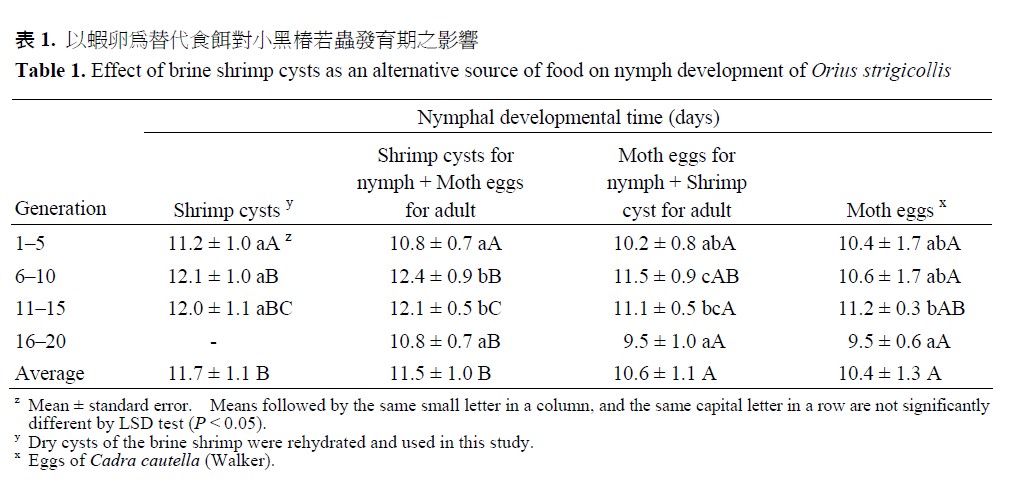All issues

Author:Chiu-Tung Lu, Yi-Chung Chiu, Meng-Yu Hsu, Chin-Ling Wang, and Feng-Chyi Lin*
Abstract:
The predatory bug, Orius strigicollis (Poppius), is usually mass-reared on eggs of the flour moth, Cadra cautella (Walker). The objective of this study was to determine if the rehydrated dry cysts of brine shrimp, Artemia franciscana, can be used as an alternative source of food to replace eggs of flour moth for mass rearing of O. strigicollis. The O. strigicollis were reared on 4 combination food, shrimp cysts for lifetime, moth eggs for lifetime, shrimp cysts for nymph and moth eggs for adult, moth eggs for nymph and shrimp cyst for adult, comparing influence on development and fecundity for successive generations. Complete replacement of moth eggs by shrimp cysts was not feasible, resulting in a longer period of nymphal development, lower emergence rate, shorter adult longevity and a great reduction in adult egg production. Continuous observations were made when O. strigicollis was fed separately on shrimp cysts and moth eggs during the nymph stage and the adult stage for 20 successive generations. Comparisons of growth and reproduction were made between those fed only on moth eggs. The results showed that feeding of the bug using shrimp cysts during the nymph stage and moth eggs during the adult stage is an acceptable way for mass rearing. The nymphal developmental period was one day longer than that of the moth egg-fed O. strigicollis, however, there was an increase of 23–28% in the number of eggs produced by the female adult. Mass rearing with 150 pairs of adult flower bugs reared together in a unit bag, the numbers of eggs produced were higher than or equal to those fed on moth eggs only. These results showed that the alternating use of shrimp cysts and moth eggs at proper stages is adoptable for long term rearing. This can save the cost of food, and is appropriate for use in the mass production.
Key words:Brine shrimp cyst, Artemia sp., Orius strigicollis, Mass rearing, Food
Download:![]() PDF Links
PDF Links
- 1. Development of Tractor-Mounted Seedling Transplanter for Sweet Potato
- 2. Synergistic Effect of Additional Gas on the Toxicity of Phosphine to Sitophilus oryzae and Sitophilus zeamais (Coleoptera: Dryophthoridae)
- 3. Effects of Temperature and Solar Radiation on Growth Traits and Plant Elements in Purple Leafy Sweet Potato
 Submit your manuscript
Submit your manuscript
 Guide for authors
Guide for authors